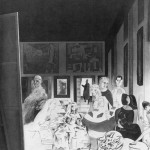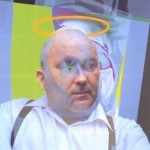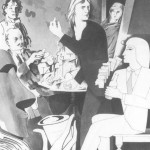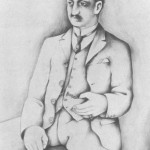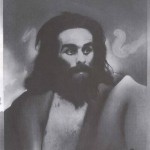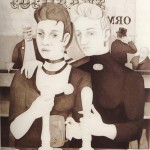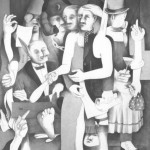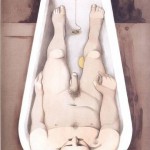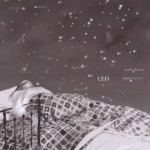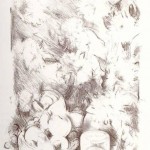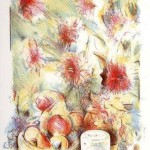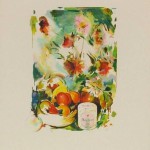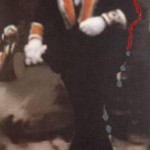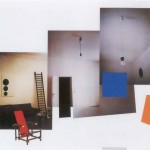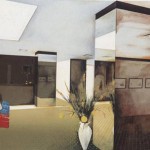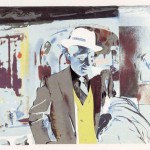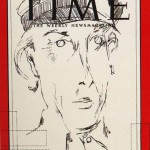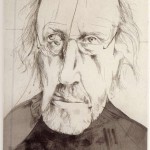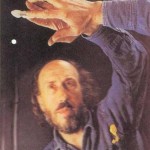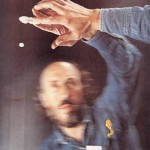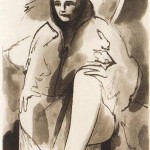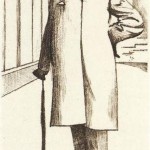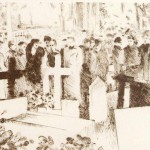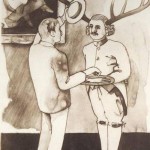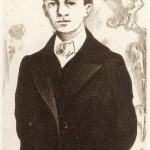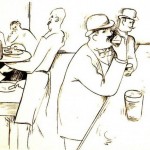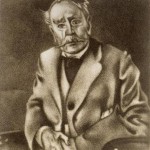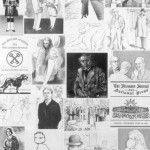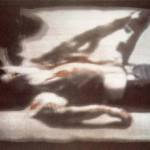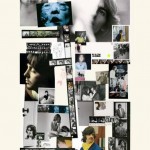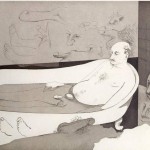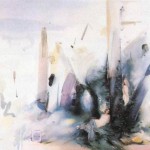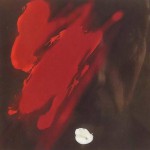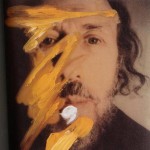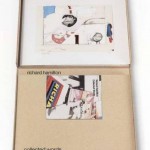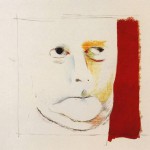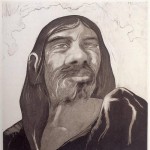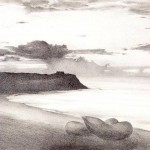RICHARD HAMILTON (Reino Unido, 1922)
From May 18 to June 21, 2010
Printmaking is a fascinating activity. Part of its attraction is that it can be done at all. In this cloning of an authentic, authoritative, individual yet repeatable mark there is a kind of sorcery. It is a genetic mimicry that parallels organic creativity. Perhaps this unthinking ability of an image to give birth to itself persuaded Watteau to the habit of counter-proofing. Having made a drawing with sanguine crayon he could make a reflection of it, transferred simply by pressing it against another piece of paper. No doubt the artist craftsmen of the 16th century who chased ceremonial armour and weapons for the nobility found it gratifying to possess a shadow of their work by filling the exquisitely engraved lines with pigment to make an impression on paper from the metal drawing.
Given one likeness why not two? It is commonly supposed that the objective of printmaking is multiplication, but this may too obvious an explanation for an activity that is often its own justification. For Rembrandt, Seghers, Goya or Picasso the print has a higher purpose, the goal of the endeavour lies in what it can offer above the direct autographic signature. On first approaching a print medium an artist may be surprised to discover the process itself putting an unexpected richness in his hands. The experienced printmaker will be drawn to the press for an enhancement of his image that results from a particular integration of pigment and paper; for the undisturbed toning of an area possible with aquatint but which cannot be painted with brush and ink; for the serene layering of colour, opaque or transparent, available with screenprint; and for qualities that the squeezed transfer from a cooper plate of finely-ground carbon pounded into stiff linseed oil alone can provide.
Nevertheless, it is the ability to proliferate which disengages print from the exalted loneliness of high art. Print counters the ideal of originality, it undermines the status of the culture-fetish value merely for being unique. Art, that solitary prerogative of humanity which separates it from the blind fecundity of nature, is subverted. The wider dissemination of printed images, an area explored in The Beatle and Kent State has great attractions. The difficulties, aesthetic and pragmatic, inherent in producing quantities sufficiently large to bring about the Gutenberg revolution granted to literature, and at the same time satisfying the selfish demands of both quality and permanence, still make a formidable obstruction. An unsigned offset print (like The Beatles) produced in huge quantities may be worthwhile if it is honestly conceived for its process. The 5,000 signed screenprints of Kent State, each nurtured with the same devotion attention that tan edition of 100 might have been given, demonstrated the possibility of the achievement of high numbers with some distinction but proven also the unforeseen impracticability of approaching the task with craft procedures and standards.
Walter Benjamin, in a famous essay, declared approvingly, “that which withers in an age of mechanical reproduction is the aura of the work of art”, and he cites the invention of woodcut in the middle Ages as the entry of mechanical reproduction into the Western consciousness. The distinction between the exclusive work of art and the replica, and the importance of this concept as an instrument of social and political change is clear, but what Benjamin does not explain is the mysterious ability of certain workers in the field of graphic art to endow the plural object with the aura he denies it.
Marcel Ducham’s persistent efforts to knock Art’s halo askew took number as his most powerful weapon. To make more of a thing deprived the original of a synthetic value. The thought alone, carried by a signifier of that thought (contrived or ready-made), had to bear the aesthetic weight. His delight in the idea that his Large Glass masterpiece should be replicated was another aspect of his rejection of the notion of the artist’s godlike touch. Despite the intention, his majestic intellect defeated itself by bestowing, unwittingly, an aura to several mundane, manufactured objects, subsequently reconstructed as multiples. The reason for failure, in his own terms, were his fastidious mind and the precision employed in the execution of its thought.
The creation of pictorial images is far removed from Duchamp’s concern but his daring stratagems are relevant to at least one of my interests in print –the possibility of fabricating an image without involving the gestural identity we recognize as the stamp of an individual artist. A little bit of Roy Lichtenstein for… makes sense seen only in this light, as does the more complex My Marilyn. In spite of this distancing of the artist’s hand, these two, and many more as different from each other as they are from them, do not preclude the possibility of apprehending a single mind at work in each.
To some extent all the print media insulate the hand from the image, lithography less than most: drawing on limestone is much like drawing on paper. The proof pulled from the stone aims at being a true mirror-image of the artist’s work. Though close to lithography in many ways, collotype is quite dissimilar in that it hinders direct manipulation by the artist. This difference could go some way to explain my perverse reservations about lithography and my affection for collotype. Collotype and photogravure are in essence what lithography in its offset from became, a means of reproduction; to use collotype as an artist’s print medium places the onus on decision-making rather than on manipulative skills. Perhaps I am lured to photogravure for the reasons that I love collotype. Neither of these sadly dying artists is capable of producing an artist’s print unaided but they can make a splendid contribution to a mix.
An engagement in photography as an augmentation of visual expression should be distinguished from its applications in the technology of reproduction. One unfortunate aspect of the introduction of photographic colour-separation to the craft studio is the ease with which it can produce a plausible imitation of an image born and reared in another environment. The successful transition of his work into another mode of intercourse can beguile an artist into the belief that he is responsible for the result. A virtue of the older methods of printmaking is the way they set traps which inhibit the concept of reproduction.
Photography has become a useful extension of the image-maker’s tool kit. Modern painters have undertaken various forays into the possibilities of incorporating photosensitive techniques into the artist’s range of media –but with such attendant difficulties that an awareness has come about that the least problematic, and certainly most permanent, solution is to paint simulations of photography for those passages demanding it. Print, in its many varieties, can give all the desired advantages but reduce the technical problems integration between hand-drawn and photographic elements can be total; collage assumes another meaning when material unification of the pictorial components is absolute.
Collage has other connotations in printmaking. Each area of technique has its particular vocabulary. A cooper plate can be worked with soft-ground, hard-ground, aquatint, sugar-lift, or bitten without an acid-resistant mask. There are subtle differences between a line eroded by nitric acid and one bitten by ferric chloride. The rough scar of a line scratched dry with a steel point is unlike the score of a diamond, or the channel firmly incised with a burin, or the soft linear gradations of dots from a roulette; the abraded lights introduced into the dense tones of aquatint with a scraper are different from those smoothed in with a burnisher. It is a rich repertoire of beauties. To move beyond the confines of a single craft and mix collotype with screenprint, photogravure with aquatint, etching with screenprint, offset with diestamping makes regarding inter-actions. Dye-transfer, and the new technologies of electronic scanning, will reveal other areas of development in the technology of the arts.
Of course, the art of drawing also offers a wide range of technical possibilities. But drawing does have curious limitations in being psychologically constricting. It seems almost as though to elaborate a drawing is an unjustifiable self-indulgance. The typical European master drawing is a study for a painting, a staging post in the journey to the ultimate objective, the major work. A print, although its scale, its paper support and many other attributes relate it to drawing, can bear the prolonged intensity of attention a large painting can tolerate. It is as though the effort, when divided by the number of the edition, is so dispersed as to make the ambition less pretentious. A drawing is essentially personal, exploratory, tentative, and to some extent provisional. A print is a public commitment, it must be resolved, perfected and finalized. Print is by definition ubiquitous. For an artist such as myself, whose very opus is ponderously contrived, there is a potency in print to put abroad the thoughts so arduously garnered.
 Español
Español  English
English 